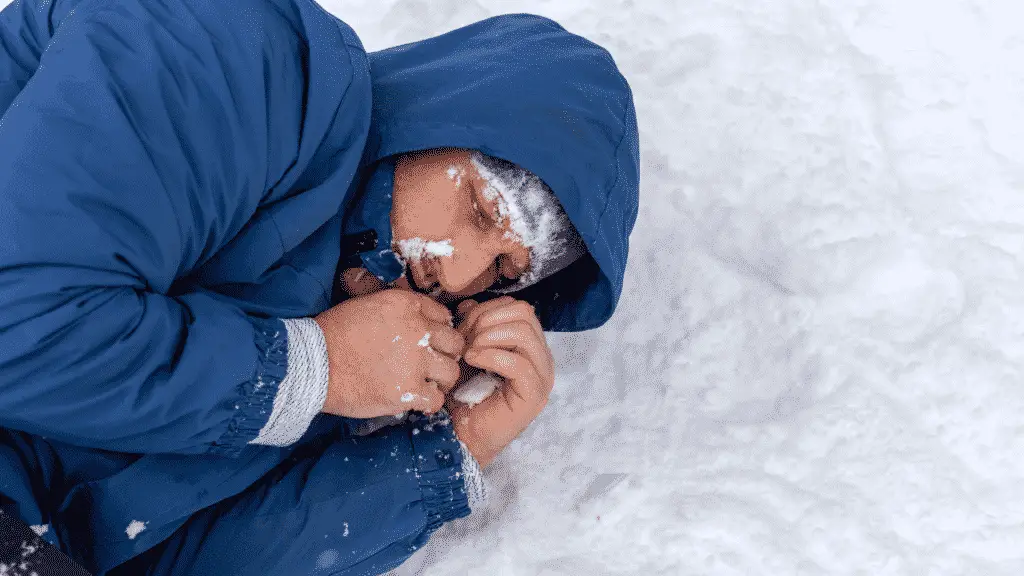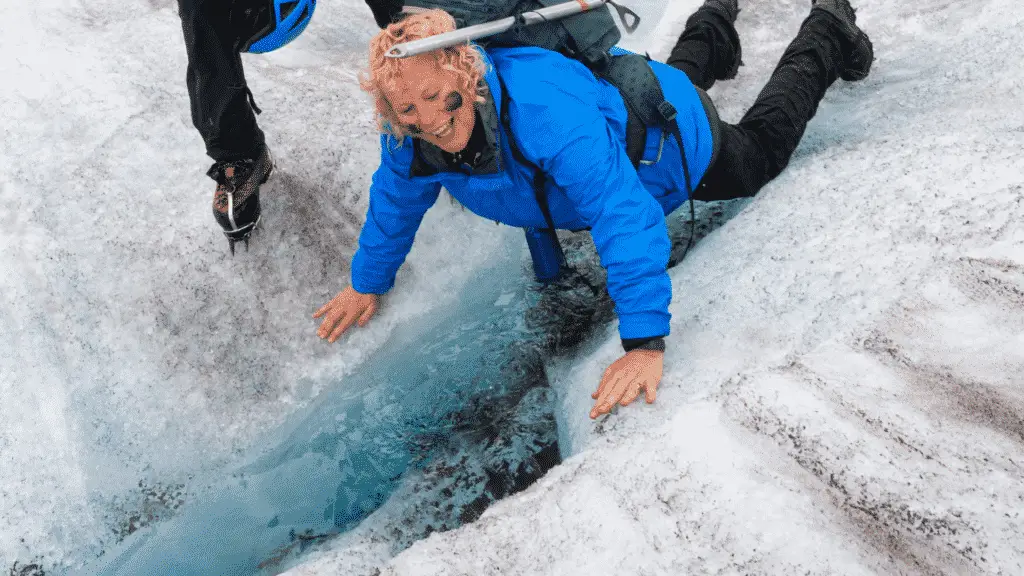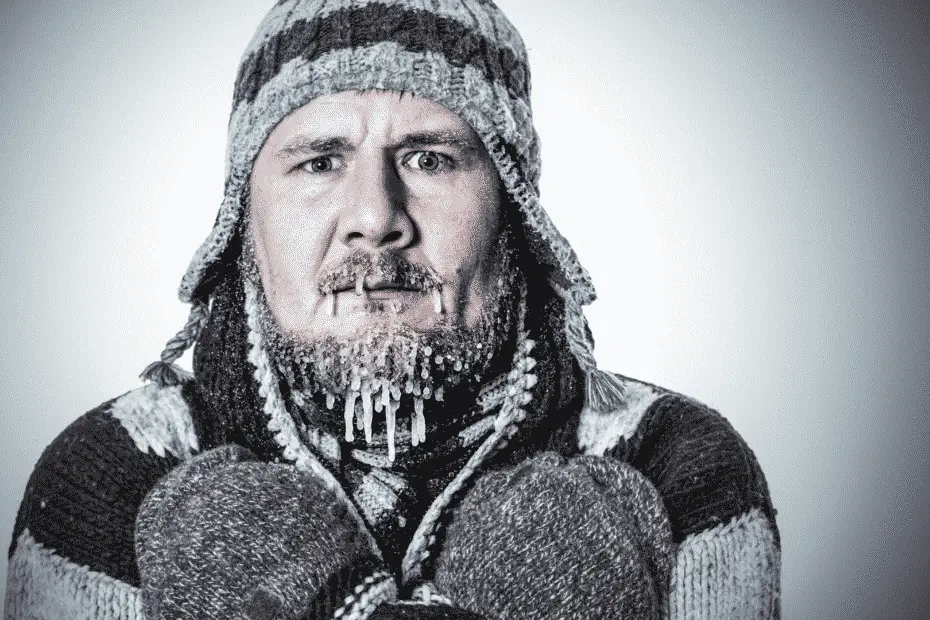Ever wonder just how cold it would need to get before you freeze to death? That thought pops into my mind every time I get the uncontrollable shivers. You might be surprised that it doesn’t have to be “freezing” to freeze to death. A moderately cold night might push your body past its limits.
What’s the lowest temperature a human can survive without freezing to death? Humans freeze to death when their internal body temperature drops below 70 degrees. It’s possible to freeze to death in 40 degree temperatures, but that’s rare. The amount of time you can survive in the cold drops along with the temperature.
Most of the boundaries that humans can survive are well known. We all know the “rule of three” for air, water and food(3 minutes without air, 3 days without water and 3 weeks without food), but we don’t know the other limits of human survival.
You never really think about testing the boundaries of life until you’re in a life or death situation. We never plan on freezing to death, but you never know what’s going to happen in the winter. So what’s the lowest temperature a human can survive?
Table Of Contents
What’s The Lowest Temperature a Human Can Survive?
It’s hard to accurately test the human body without putting the patient in danger. However, over the past few decades there have been a few experiments that test the limits of the human body.
Figuring out what temperature a human freezes to death is actually kinda hard. How one person responds to changing temperatures will be completely different to the next. It all depends on the person, temperature, water saturation, and how long you’re exposed to freezing temperatures.
It’s also going to depend on how fast the temperature changes from the norm. The body can typically make subtle adjustments to handle frigid temperatures. Our body starts constricting blood vessels transporting warm blood to the internal organs.
We typically freeze to death when our body temperature drops to 70 Degrees(plus or minus a couple degrees). How long that takes will depend on how much time you spend in the cold and your level of fitness. In general if the temperature is below 40 degrees there is a chance of freezing to death.
Freezing to death in 40°F weather is unlikely, but it does happen. I’ll get into the extenuating circumstances that increase your risk of freezing to death in the following sections.
Extreme Cold Is More Dangerous Than Heat
Most people are under the misconception that heat is more dangerous than extreme cold. You might be surprised to learn that people are 20 times more likely to freeze to death than die from hot weather. Scientists have even fall for that trap with most of their weather related research focusing on heat wave death.
People are freezing to death all over the world and nobodies doing anything to warn us of the dangers. Unfortunately, it’s extremely difficult to research without seriously injuring somebody. Here’s a brief rundown of how our body works.
Your body’s core temperature should stay in the vicinity of 98.6°F (37°C). Once your body temperature drops below 95°F hypothermia starts to take hold. This is when your heart, brain, lungs, etc. start to struggle. Once your body drops below 91°F you’ll likely experience amnesia and won’t be able to recover without medical intervention. At 82°F you’ll go unconscious and death occurs at 70°F on average.
That sounds easy enough to gauge, but it’s hard to pinpoint when people will reach these internal body temperatures. It’s really hard to estimate the temperatures it takes for a person to freeze to death (I’ll explain more below).
A healthy person might be able to survive a 20°F night without shelter, but a 80 year old women could pass away on a 50°F night in bed. Throw in some water/wind and it muddies the estimate further. That’s why you should always take hypothermia seriously and find warm shelter immediately.
When Does a Person Freeze to Death?

A person freezes to death when their core temperature starts to drop. Our core body temperature typically hovers around 98.6 degrees Fahrenheit. Hypothermia doesn’t start to set in until your body temp drops below 95 degrees.
It doesn’t have to be freezing to experience hypothermia. You can actually experience hypothermia between 30-50 degrees Fahrenheit. Hypothermia at modest temperatures is fairly unusual, but it does happen. You would have to be exposed to those temperatures for a very long time with minimal insulation to keep you warm.
If you’re wet the temperature range may be even higher. Your body loses temperature much faster in water than air (almost 25 times faster). Anybody that’s hopped in the water on a chilly day can attest to the temperature difference. It can be 70°F out and you’ll be shivering after hopping out of the water.
People Freeze To Death At Different Temperatures

A typical person will freeze to death when their internal body temperature reaches 70°F. That’s when your internal organs start to shut down and become permanently damaged. However there are many cases where people have survived body temperatures well below that point. They’re basically comatose and unable to move, but they somehow manage to survive.
There was a woman named Anna Bagenholm that fell into a frozen stream while skiing in 1999. When the rescuers found her body she had an internal body temperature of 56.7°F. All signs pointed to guaranteed death, but she somehow managed to survive. That’s the coldest recorded temperature a person has ever survived.
Could a person survive colder body temperatures than that? Who knows! That was a special circumstance, but I’m sure there will be other extreme cases in the future. It all depends on the person and whether or not they’re physically healthy.
Surviving Subzero Temperatures
Trying to survive in subzero temperatures is a whole different beast. When the temperatures drop below negative 20 you can freeze to death in 10-20 minutes. At colder temperatures (-40) you can get hypothermia in under 5 minutes.
However, you don’t need to be in a frozen lake or freezing temperatures to die of hypothermia. You can die in 50°F weather if you’re wet or there’s an extreme wind chill. The body loses heat 25 times faster in water and a cool breeze speeds up the temperature loss.
It’s estimated that 90% of cold weather deaths happen in mild weather. That’s why you should always dress for cold weather and try to stay dry when you’re exposed to the elements. With proper cold weather gear you can last much longer, but you will eventually succumb to the cold.
Think of your winter gear as an insulation layer between your body and the cold outside air. Your winter clothing traps body heat, but it’s only as effective as the insulation layer. If your body heat escapes faster than you generate heat the internal temperature will drop fast. You will never reach the exterior temperature, but hypothermia can set in at higher temperatures than most people realize.
Stages of Hypothermia
Symptoms of mild hypothermia (95 Degree) tend to seem fairly mild. You’ll start to experience shivering, general weakness and mild confusion. Letting your body temperature drop lower can be downright deadly.
- Below 95 Degrees: You’ll start shiver, feel weak and mild confusion may occur.
- Below 91 Degrees: Your body starts to shut down with amnesia occurring. All sense of survival skills will be forgotten.
- Below 82 Degrees: Loss of consciousness occurs. Without immediate medical attention death is a serious possibility.
- Below 70 Degrees: When body temperature drops below 70 degrees death is almost inevitable. Even though some adults have been known to survive, profound hypothermia has occurred.
Signs of Hypothermia
Dehydration, lack of food, and fatigue makes you more susceptible to hypothermia. Not everybody is affected the same way by cold weather. One member of your group can be affected with hypothermia while everyone else is fine. It’s important to recognize the symptoms and warm up the victim quickly.
Early Warning Signs
- Complaints of feeling cold
- muscle cramps
- General Fatigue
- Uncontrolled Shivering
- Confusion and inability to follow verbal commands
Dangerous Warning Signs
- Slurred Speech
- Confusion and inability to focus
- violent outbursts
- Stumbling and Falling
- Coma and Death (If Left Untreated)
Our Bodies Can Get Colder Than You Think
Coming out of an ice age, our bodies are actually pretty hardy in the cold. We have a few mechanisms to protect our vital organs from freezing conditions.
Once cold air starts to hit your face your body starts working to insulate itself (it’s called vasoconstriction). It starts moving blood away from the skin and external extremities towards the internal organs.
This is how your body protects vital organs in the cold. That’s why your fingers and toes are the first body parts to get cold. You can lose a few fingers and survive, but damaging your vital organs can be deadly.
Your body also starts to shiver trying to produce body heat. This extra body movement will help raise body temperature. Shivering might seem like a bad thing, but it means your body’s still putting up a fight. You should be even more concerned if your body starts shivering because that means your going into the problematic stages of hypothermia.
Water Speeds Up Hypothermia

Hypothermia can occur in open air, but it’s most common in the water. On cold weather backpacking/camping trips falling in water can be a death sentence. Water saps heat away from the body fast so you need to deal with the problem fast.
When getting out of the water quickly put on dry clothes and seek shelter. If your teeth start chattering and you start shivering hypothermia is soon to follow. Put on warm clean clothes and try to increase your internal body temperature.
Hopping in your sleeping bag to conserve body heat is one of the best ways to increase your internal temperature. Synthetic sleeping bags are a little bit heavier than down, but they’re far better at maintaining insulation when wet.
Treating Hypothermia
To treat hypothermia you need to get the victim to shelter quickly. Either a premade structure or build a quick shelter to escape the wind, rain and cold. Remove all wet clothing and replace with dry clothes and blankets.
Light up a fire and give them a warm sugar filled drink. Sugar is easy for the body to burn increasing internal body temperature. Use emergency rations to increase the blood sugar level.
If you’re alone and find yourself shivering and showing signs of hypothermia you need to act quickly. Get out of the wind/rain and strip out of wet clothes. Use all of your emergency rations and try to get warm. Immediately signal for help and if possible light a fire.
If you don’t stop the progression of hypothermia quickly you’ll lose consciousness so you need to act immediately. Remember that you’ll feel a lack of motivation and hopelessness, but you need to work through it. Call for help and build a fire while you’re still able to function.




